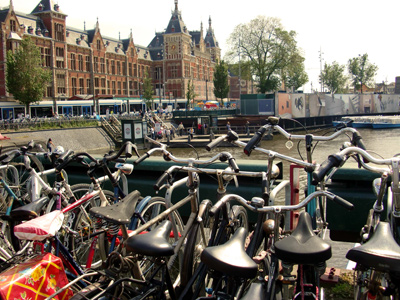| Official Name: | Netherlands | Population: | 16.3 million people |
| Capital: | Amsterdam | State language: | Dutch |
| Form of Government: | Constitutional Monarchy | Administrative division: | Netherlands has 12 provinces |
| International phone code: | 31 | Time difference with Moscow: | -2 hours |
| Monetary unit: | Euro (EUR) | Rate: | 1 EUR = 92.09 RUR |
EDUCATIONAL INSTITUTIONS
- Undergraduate Courses
- Amsterdam University of Applied Sciences
- HAN University of Applied Sciences
- Hanze University of Applied Sciences
- Holland International Study Centre
- NHL Stenden University of Applied Sciences
- The Hague University of Applied Sciences
- University of Amsterdam
- University of Twente
- Webster University
- Wittenborg University of Applied Sciences
- Postgraduate Courses and MBA

INFORMATION ABOUT THE NETHERLANDS AND EDUCATION SYSTEM
Basic information about the Netherlands.
The Netherlands is located in north-western Europe. It is bound by the North Sea to the north and west, Germany to the east and Belgium to the south. It is one of the most densely populated countries in the world: more than 16.3 million people inhabit a territory of 41,528 sq. km. 26% of the inland area lies below sea level and is protected by coastal dunes and dykes. The Netherlands can be rightfully called the gates of Europe: important European waterways –rivers Rhine, Meuse and Scheldt flow across the Netherlands to the North Sea, and Rotterdam is the largest sea port in Europe. The Kingdom of the Netherlands consists of the Netherlands, the Netherlands Antilles and the Aruba Islands in the Caribbean. It is a parliamentary constitutional monarchy. The Head of State, Queen Beatrix, ascended the throne in 1980.
The capital of the country is Amsterdam, but the Hague is the seat of the monarchy, government and parliament. The official languages are Dutch and West Frizian, while the majority of the population has good command of English. Despite its small size and relatively small population, the Netherlands ranks 6th in the world rating of exporters and investors, and holds 3rd place in agricultural exports worldwide. There are around 1000 museums in the Netherlands - no other country can boast such a density of museums. Nowadays, centuries-old traditions in Art, Architecture and Housing are held up for world wide appreciation and recognition.
Higher education in the Netherlands.
The Netherlands higher education system is represented by three types of institutions:
• Research Universities (WO)
• Universities of Applied Sciences (HBO)
• Institutes for International Education (IO)
The universities (WO) focus on independent research-oriented work in an academic or professional setting. The universities of professional education (HBO) are more practically oriented, preparing students directly for specific careers. The universities and universities of professional education award both Bachelors and Masters degrees, but with a difference in orientation: most degree programmes at universities focus on science, and those at universities of professional education on applied science. The institutes of international education (IO) offer Masters and Postgraduate (PhD) programmes designed specially for foreign students.
• 14 Universities
Bachelors: 3 years (180 credits)
Masters: 1-2 years (60-120 credits)
PhD: 4 years
• 54 universities of professional education:
Bachelors: 4 years (240 credits)
Masters: 1-2 years (60-120 credits)
• 11 institutes of international education:
Masters: 1-2 years (60-120 credits)
PhD: 4 years
Study In The Netherlands
The Netherlands leads continental Europe in terms of the number of international study programmes offered in English.These include 1390 Bachelors and Masters degree programmes (data from the 2009/2010 academic year) as well as short courses of various durations in different fields. Foreign students with a good knowledge of Dutch may also enrol in Dutch-taught Bachelors or Masters programmes at Dutch institutions. The high level of educational and research programmes is achieved through the national system of accreditation and quality control. According to the “Times Higher Education Supplement”, 10 of the 14 Dutch universities are ranked among the 200 best higher education institutions in the world. The Netherlands has long-standing experience of international cooperation in the sphere of higher education. More than 49,750 foreign students study in the Netherlands, accounting for around 9% of the total number of students.

 +7 (495) 228 03 00
+7 (495) 228 03 00
 Netherlands
Netherlands


